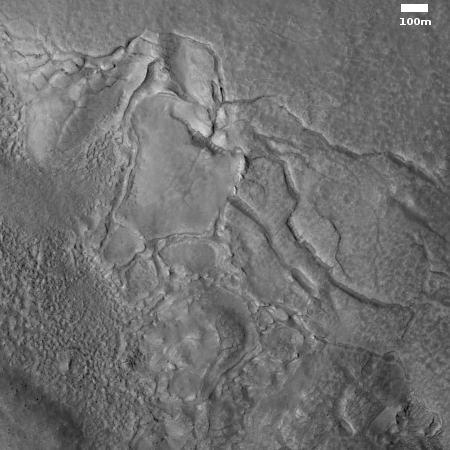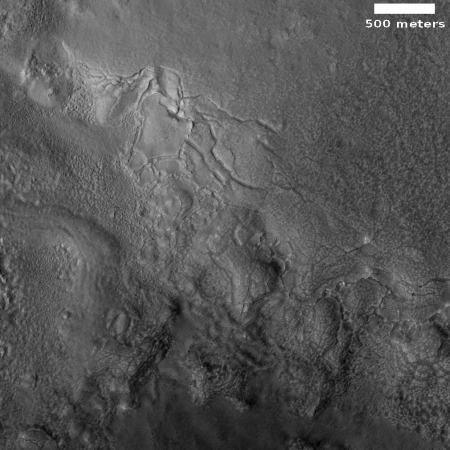Glacial breakup on Mars
Cool image time! The photograph to the right, cropped and reduced to post here, was taken by the high resolution camera on Mars Reconnaissance Orbiter on December 22, 2019 and was titled “Contact Between Debris Apron and Upper Plains in Deuteronilus Mensae”.
The section of the full image that I have focused on shows what appears to be the downhill break-up of the surface debris covering an underlying water ice glacier. The grade is downhill to the south.
I am confident that this is buried glacial material based on recent research:
- November 22, 2019: Mars Express confirms ancient glaciers in northern Martian mid-latitudes
- December 20, 2019: More evidence of ample shallow ice in Martian mid-latitudes
Both of these reports found lots of evidence of shallow ice in Deuteronilus Mensae, a region of chaos terrain in the transition zone between the Martian northern lowlands and the southern highlands.
With this image we see what appears to be the slippage of that ice downslope, causing breakage and cracks on the surface, with much of that surface made up of the dust and debris that covers the ice and protects it. Towards the bottom of the image it even appears that the disappearing ice is unveiling the existence of a bunch of buried bedrock mesas, typical of chaos terrain, previously hidden by the ice because it filled the surrounding canyons.
Below is a close-up of the photograph’s most interesting area of break-up.

The cracked sections here are very reminiscent of similar glacial break-ups here on Earth, except here the underlying material is not liquid water but solid ground.
Is this glacier active? Very unlikely. It was growing in the past, when Mars’ inclination was much higher that today’s 25 degrees (comparable to Earth). When that inclination was 50 degrees, the poles were warmer than the mid-latitudes where Deuteronilus Mensae is located. Water would sublimate into the atmosphere at the poles and fall as snow here. That snowfall would cause the glacier to slowly flow downhill, which would result in this cracking at the glacier’s foot.
On Christmas Eve 1968 three Americans became the first humans to visit another world. What they did to celebrate was unexpected and profound, and will be remembered throughout all human history. Genesis: the Story of Apollo 8, Robert Zimmerman's classic history of humanity's first journey to another world, tells that story, and it is now available as both an ebook and an audiobook, both with a foreword by Valerie Anders and a new introduction by Robert Zimmerman.
The print edition can be purchased at Amazon or from any other book seller. If you want an autographed copy the price is $60 for the hardback and $45 for the paperback, plus $8 shipping for each. Go here for purchasing details. The ebook is available everywhere for $5.99 (before discount) at amazon, or direct from my ebook publisher, ebookit. If you buy it from ebookit you don't support the big tech companies and the author gets a bigger cut much sooner.
The audiobook is also available at all these vendors, and is also free with a 30-day trial membership to Audible.
"Not simply about one mission, [Genesis] is also the history of America's quest for the moon... Zimmerman has done a masterful job of tying disparate events together into a solid account of one of America's greatest human triumphs."--San Antonio Express-News
Cool image time! The photograph to the right, cropped and reduced to post here, was taken by the high resolution camera on Mars Reconnaissance Orbiter on December 22, 2019 and was titled “Contact Between Debris Apron and Upper Plains in Deuteronilus Mensae”.
The section of the full image that I have focused on shows what appears to be the downhill break-up of the surface debris covering an underlying water ice glacier. The grade is downhill to the south.
I am confident that this is buried glacial material based on recent research:
- November 22, 2019: Mars Express confirms ancient glaciers in northern Martian mid-latitudes
- December 20, 2019: More evidence of ample shallow ice in Martian mid-latitudes
Both of these reports found lots of evidence of shallow ice in Deuteronilus Mensae, a region of chaos terrain in the transition zone between the Martian northern lowlands and the southern highlands.
With this image we see what appears to be the slippage of that ice downslope, causing breakage and cracks on the surface, with much of that surface made up of the dust and debris that covers the ice and protects it. Towards the bottom of the image it even appears that the disappearing ice is unveiling the existence of a bunch of buried bedrock mesas, typical of chaos terrain, previously hidden by the ice because it filled the surrounding canyons.
Below is a close-up of the photograph’s most interesting area of break-up.

The cracked sections here are very reminiscent of similar glacial break-ups here on Earth, except here the underlying material is not liquid water but solid ground.
Is this glacier active? Very unlikely. It was growing in the past, when Mars’ inclination was much higher that today’s 25 degrees (comparable to Earth). When that inclination was 50 degrees, the poles were warmer than the mid-latitudes where Deuteronilus Mensae is located. Water would sublimate into the atmosphere at the poles and fall as snow here. That snowfall would cause the glacier to slowly flow downhill, which would result in this cracking at the glacier’s foot.
On Christmas Eve 1968 three Americans became the first humans to visit another world. What they did to celebrate was unexpected and profound, and will be remembered throughout all human history. Genesis: the Story of Apollo 8, Robert Zimmerman's classic history of humanity's first journey to another world, tells that story, and it is now available as both an ebook and an audiobook, both with a foreword by Valerie Anders and a new introduction by Robert Zimmerman.
The print edition can be purchased at Amazon or from any other book seller. If you want an autographed copy the price is $60 for the hardback and $45 for the paperback, plus $8 shipping for each. Go here for purchasing details. The ebook is available everywhere for $5.99 (before discount) at amazon, or direct from my ebook publisher, ebookit. If you buy it from ebookit you don't support the big tech companies and the author gets a bigger cut much sooner.
The audiobook is also available at all these vendors, and is also free with a 30-day trial membership to Audible.
"Not simply about one mission, [Genesis] is also the history of America's quest for the moon... Zimmerman has done a masterful job of tying disparate events together into a solid account of one of America's greatest human triumphs."--San Antonio Express-News



so how long will it take for someone to cite this Martian glacial crackup as conclusive proof of anthropogenic climate change?